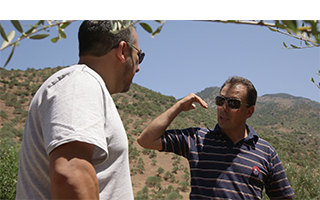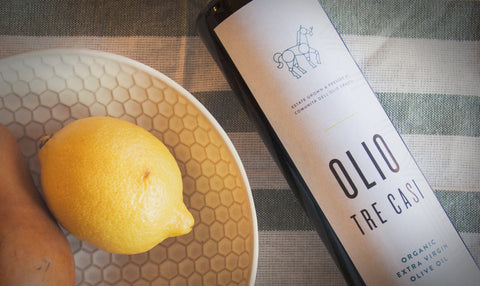Harvesting Olive Oil: Olio Tre Casi
In the shadow of Sicily’s world-famous volcano, Mt. Etna, emerge the incredibly beautiful mountains of the Parco delle Madonie. With peaks reaching up 2,000 meters, it could prove easy to get swept up in a land that so effortlessly combines sea, mountains and culture. However, we happened upon something equally as exceptional during our visit to Parco delle Madonie.
Within the picturesque landscape of Palermo, Sicily lies a National Park filled with olive groves that are home to the U Crastu olive—an olive so remote, so special that even some natives of Palermo aren’t aware of their existence.
As an offspring of the Nocellara olive—one of the most coveted varieties of olives—these U Crastu olives gave life to DITALIA’s newest specialty olive oil: Olio Tre Casi.
From its history to its harvest, let’s take a look at what makes olive oil one of the most prized possessions of any Italian pantry.
A Brief History of Olive Oil
Olives are the earliest crop known to be cultivated by humans, having been grown even before the written language was invented.
Anciently used for a variety of purposes: including lamp fuel, pharmaceutical ointment, and even in rituals for anointing royalty, olive oil has since evolved to become the backbone of authentic Mediterranean cooking.
Today, olives are cultivated and commercially produced on more than 23 million acres in the Mediterranean basin as well as some new plantings in areas such as Chile, Argentina, South Africa, and Australia.
How It's Made
Despite their noble history and legendary reputation, the olive tree (to some) may appear to be ordinary at best. However, when it comes to harvesting its fruit, it’s no simple task.
To harvest olives at the right time, olives are typically picked in October through early November—right when the fruit’s color turns from green to a purplish hue. Perfecting when to pick the olives is how producers are able to get the most health benefits from the olive—more polyphenols, good fat, etc.
Then, like the Olive Oil Times (yes, that’s real) notes: “Extra virgin olive oil is made by crushing fruit and extracting the juice. Nothing else.” However, there are a few more steps involved in making extra virgin olive oil than simply squishing a few olives then bottling the oil.
Once picked, the olives go to press right away. Essentially, high-quality olives should be sent to be pressed between 9-16 hours after being picked. If you wait much longer, you will get more oil from them, but they start losing their nutritional values.
What Separates The Good from The Great
Experts agree that olive oil—especially extra virgin olive oil—is good for you, providing a variety of health benefits. But when it comes to flavor, just like with any food, every person’s palette and preference is different. The ‘best’ olive oil is typically subjective, but there are a few things that separate the high-quality olive oils from the rest.
Look for the harvest date
Unlike fine wine, olive oil isn’t meant to be aged. Which is why the two most important things to note are the year of harvest and "best before" date. This is because flavor continues to altar from the moment it’s pressed, so ‘great’ olive oils tend to have a shelf life of 24-30 months. That being said, if the back of the label doesn't list a harvest date...you may consider putting that bottle back on the shelf.
Acidity Levels
Typically, good olive oil will have 1 percent or less acidity level, whereas higher-quality olive oils are often below this—possibly around a .23 acidity level. Anything with an acidity level of 3 percent or higher would qualify as virgin olive oil rather than extra virgin. You may also want to see which brands have a high rating (around 6.5 or above) for organoleptic qualities—meaning how good it smells, tastes and looks.
Put your nose to the test
Color isn't necessarily a tell-all when it comes to quality olive oil. Although you should be worried if it's not green or yellow, there are ways to add color to olive oil to make it look deeper and richer. While this may work at first sight, you can’t use tricks when it comes to smell. For example, think of the feeling you get when you take in the aroma of freshly cut herbs or tomatoes. After your taste buds, your nose will always be the next best judge of high-quality olive oil.
What Makes Olio Tre Casi Special?
'A great producer is going to have their own olives, know everything about them, pick them at their prime and get them to press between 9-16 hours,’ says Vince Di Piazza. Which is exactly what three families in the mountains of Madonie, Sicily have been doing for centuries.
On a trip to Sicily, Vince Di Piazza, head of DITALIA Fine Italian Imports, discovered a uniquely exquisite olive oil, Olio Tre Casi; cultivated by the La Plena, Giaimo, and Zito families. Nestled in Palermo among 4000 acres of natural forest, the Olio Tre Casi is made from the rare U Crastu olive, which grows only on the cliffs of Madonie.
Today, DITALIA is thrilled to bring this extra virgin olive oil to America for the first time. Cold-pressed from 100% organic U Crastu olives, this is truly an extra virgin olive oil like no other.
As a family-owned company, not only are we proud to bring our customers something so profoundly special, we are also honored to support small, farmer cultivations like those of the La Plenas, Giaimos and Zitos—and we hope you will, too!








